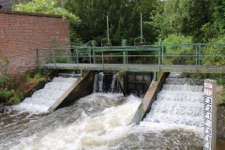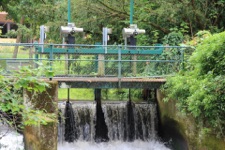History
The Landings, a development of 60 houses bordered by the river Wey and Godalming Navigation.
The houses were started in the early 80’s after much opposition from the local planning authority.
The Estate owns Catteshall weir, and its operation paid for by the Estate. When the Mill was in operation the then owner of the Mill would have operated it.
The earliest record of a mill at Catteshall is claimed to be in the Doomsday book of 1086. There were three mills in Godalming at that time valued at 41shillings and 8pence. Since the 11th century the site has been used for a variety of industrial activities including corn milling, malting, fulling, paper making, tanning, engineering and foundry work. During the early 20th century the property was called Farncombe Mills.
Until the mid-19th century the mill was powered by water wheels but these were then replaced by steam engines and a water-turbine. An important feature of the mill is its position on the Godalming Navigation, formerly a convenient means of transportation for both raw materials and manufactured goods. Godalming formerly had six water mills.
The site of three of these, Eashing, Westbrook and Catteshall are on the Wey.
Eashing is upstream, Westbrook near the town and Catteshall downstream near the parish boundary with Shalford. The three remaining mills: Enton, Ockford and Hatch are on the River Ock, a fast flowing but small tributary stream, which enters the Wey near Westbrook Mill. Catteshall therefore has the greatest flow of water. This is channelled by means of a millstream along the south side of the valley to create a head of about 2m of water. This stream is now the official course of the River Wey; the original watercourse, the Old River, having been made redundant when the navigation was constructed.
It is for this reason the operation of our Weir is very important.
- The above article is by courtesy of the Surrey Archaeological Society

